SEARCH






|
|
|
|


Live interview with Jimmy Nelson in the Africa Museum – Berg en Dal, the Netherlands
by Marc van Kempen
Jimmy Nelson, born in 1967, is a British photojournalist and Photographer. His height and baldness lends him a striking appearance. These two characteristics would not be so interesting if they did not play a major role in shaping his life.
As a child of ex-patriots he frequently had to travel/fly alone to join his parents abroad and while in England he stayed at a Jesuit boarding school. At the age of seventeen he became bald from one day to the next due to illness. As a result of this he was banned from school. The school administrators didn't understand his sudden change in appearance and assumed he wanted to become a skinhead. Two weeks later Jimmy had to undress in front of these officials to prove that he had lost all the hair on his body and that he had not shaved his head. Once his baldness was accepted there was no reason for abasement but neither was he shown any sympathy by the same officials telling him "he had a lot of catching up to do now".
Jimmy felt like an outcast, confused by the sudden change in his appearance: "you are standing in front of a mirror, but you see somebody else". He decided to leave and travel to the only place in the world where each and every man shaves his head: Tibet.
At eighteen Jimmy was traveling and had developed close relationships with many Buddhist monks. He lived life aggressively and sex, drugs and booze played a major role.
"A learning time" he says. His tremendous curiosity for different ethnic communities took root during this time. It was the period when Lhasa rose up after many years of desolation and isolation. The place was opened up for tourists and he started to photograph. Although his work was not that good he was successful selling his images to magazines and thought: "I'm not going back to school...I want to become a photographer".
I met Jimmy Nelson in the African Museum in Berg en Dal, in the Netherlands. I realized immediately that our schedule would be very tight. His busy program involved a lecture, a photo session with the public and an interview with 1x. There was also a crew filming Jimmy Nelson's day. Time was short so we had to improvise. We had a short discussion about how Jimmy and his crew wanted to do the interview. They decided to do a tour in the Museum where his exhibition was being shown.
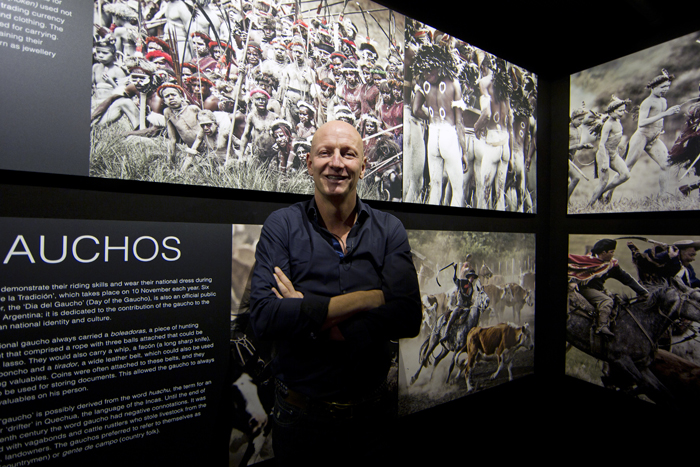 Jimmy Nelson by Marc van Kempen
Jimmy Nelson by Marc van Kempen
The brilliant overview of Jimmy's work gave an inspiring impression of peoples and cultures from all parts of the world. I noticed that his whole collection of images of the people he portrayed always had a romantic mood.
A wonderful and proud representation of their beauty, their cloths and their races.
The first question which came into my mind was if the poses, choice of cloths and settings were natural. People were mostly dressed with traditional clothing in wonderful locations ! It made me almost jealous to compare their life style with the one of the Western civilization which is often colorless. What does this artist want to tell us by the way he portrays these people?
Jimmy starts to tell us about himself.
“I was born in England in 1967 in Sevenoaks in Kent and my family was not artistic at all. My father was a geologist and my mother was a doctor. My parents moved abroad when I was very young and together we traveled all over the world during my first 7 years of life. After that period, they put me in a boarding school for 10 years and when I was 17 I lost all my hair very suddenly in one single night. That was a shocking experience for me. It made me decide to travel to Tibet to meet other people. I was there for one year and crisscrossed the country. The main reason why I choose Tibet was because all Tibetan monks are bald. I wanted to meet them because I felt connected to them.
That was the period in which I took my first pictures and was able to sell them whenever I came back to England. My life as a photographer can be summarized like this: between 17 and 24 years old I worked as a photographer reporter and when 24 years old, I became a commercial photographer for several successful international brands.
In 2010, I started working on my own projects. In the last 5 years, I have only been doing this and am no longer involved in commercial photography.
Your current work is not commercial. But you are selling a lot of books and you give seminars. Isn't that commercial?
Yes, it is commercial but I'm only selling books and photo's and giving seminars to be able to finance my own projects. I don't sell a product, I sell my story.
After that period, I got assignments to photograph various cultural themes for the news: the involvement of Russia in Afghanistan, the continuous battle between India and Pakistan in Kashmir and the beginning of the war in ex-Yugoslavia.
At the beginning of 1994, I produced “Litteraire Portretten van China” together with my wife (a native of the Netherlands). A project we worked on for thirty months which took us to many hidden places in the “New People's Republic in China. My images were exhibited in the Palace on Tiananmen Square in Peking. This exhibition was shown all over the world.
I saw some images taken in extreme cold weather circumstances. During those shoots, did you realize that such extreme circumstances may damage your special cameras? What do you do during your expeditions to avoid that?
I work with a technical camera, nothing can be damaged on these strong cameras. There is nothing electronic in it that means there is no problem at all working in extreme cold countries.
Besides my camera I carry at least 10 lenses (as a back-up). During an expedition it is more likely that something would happen to me rather than to my camera.
With an old view camera, you learn to communicate with people in your own way, with gestures, and with both eye and physical contact
A Zenith-B was my very first camera. It's choice was just a coincidence but I picked it because it looked very interesting to me and I still use it today. I used it in Tibet with Kodak Color Gold film rolls and those images were published. I always worked with Nikon F / Nikon FM / Nikon FM2 / Nikon FM3. For images like the ones exhibited here in the Museum, I still use a 4x5 inch or 8x10 inch camera.
You're traveling a lot. How do you communicate with unknown tribes?
It's stories about emotions and vulnerability and how you can communicate without language. Using emotions, passion and physical contact you can tell these people how special they are. I want to give them an audience.
While walking through the exhibition, I noted that people in your pictures are beautifully dressed. Are you looking for it or do you ask them?
You have to tell people that you want to take wonderful shots. I always tell them that I will return the day after. I always start with individual portraits and later move to group portraits. People wear their own choice of clothing. They want to be at their very best on the pictures. I want to make them proud of themselves. I never influence anybody about what they should wear. If I tell you that I will come back tomorrow to photograph you as you really are, than you will have to choose your cloths too.
You also made a series about Marken in the Netherlands. A pure Dutch label.
Yes, that was part of a project from the Folklore Museum in Leiden. They asked me to photograph Terschelling in my own way and to show people how I did it. These people are not dressed in everyday clothing but it surely is part of their culture.
Is there a difference between people from Marken and other people you photographed?
Lots of differences on one side, only a few on the other side. I want to capture their pride and when it comes to that, differences are reduced to none.
Looking at your work, I'm wondering how you work? Do you shoot a lot of images when you are on location?
Only a few, sometimes 3 or 4. I don't take that many film rolls with me, so my shots have to be perfect. It may take days to find the right location and moment so that everybody involved has a clear idea of the image that I want to shoot. It is not a reportage. As an example, I'm always waiting for the best light.
You are directing with sensibility, physical contact and emotion. How do you get exactly what you want from the group?
This image here is very esthetic and completely staged. I took care of all the details. How their hands are shown, how much light between two persons, colors and clothing. In fact, it is totally staged and directed by me.
You always go analogue, never digital?
Everything that you see here in the exhibition is analogue. In my book “Before they pass away”, there are a few images in motion and those are digital.
Right now I'm looking at a photo of a warrior in the desert. What exactly do we see here?
He is not standing there every morning and I wanted to express the poetry of the landscape and their culture. It is the land of his father, the land of his tribe. This picture has been taken around 5am. A proud warrior in his environment.
What camera did you use here?
I used a Linhof camera with a Schneider lens and self-made spacer.
These pictures are so beautiful. Have your subjects ever seen this images?
Not during the photo sessions, that is obvious. But I always try to go back to show my shots and my book to these tribes.
How do they react when they see themselves in the book and how wonderful they look?
All the members of the tribes are eager to look through the book and many ask: “where is my book?” because they all think they will get one. I always send a few exemplars to them.
I can imagine that while traveling so much to take your gorgeous images, you have to deal with dangerous situations sometimes. Were their moments in your career where you really had to confront danger and why?
The only danger that I encounter is hidden in our Western business world. When you visit tribes, money doesn't matter. It is all about human connections and if you handle it in a respectful way, there is no danger. We, from the Western world have to confront much more danger and we abuse each other much more.
Many photographers dream about being discovered and becoming famous. Do you have some advice for them? And is it still possible today?
The most important thing is not how to use your camera, but what you try to share with other people. What is the meaning behind the image? Everything has already been photographed. The story and what you want to share with the viewer is the essence.
But may be it is also a matter of luck?
I don't believe in luck. You have to create your own world. The message I want to send into the world is how rich those people are and how poor we are. If we continue to develop our materialism and if we lose these wonderful cultures than the world will be out of balance. Money really isn't the only thing that matters.
In your success for creating your own world, who inspired you the most?
My biggest inspiration was Edward Curtis. He also created his images and staging. Marcel Boekhoorn is my biggest sponsor. Without him, none of this would have been possible. He believed in me and knew I would spend his money in the best possible way. In fact, following in the footsteps of Edward Curtis.
We have arrived in the most beautiful part of the African Museum where your wonderful images are being exhibited. Can you tell us something more about the portrait series displayed here?
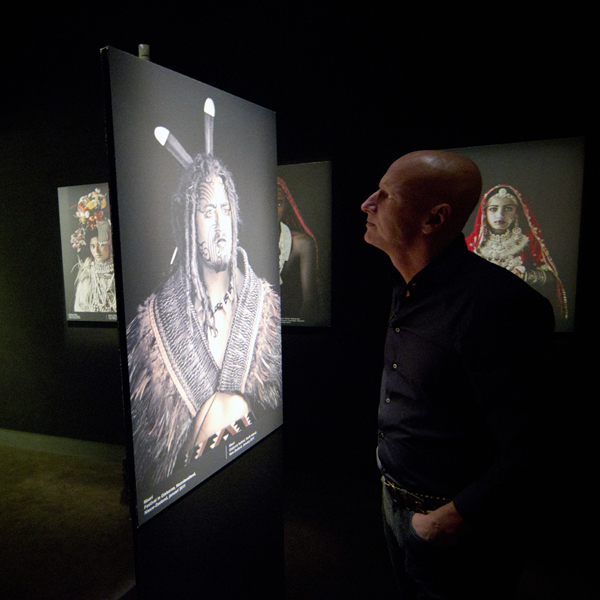 Jimmy Nelson in front of one of his exceptional portraits by Marc van Kempen
Jimmy Nelson in front of one of his exceptional portraits by Marc van Kempen
All these portraits were taken inside with a big outside reflector. In addition to that, I also used 3 more reflectors which were held by 3 people to give me even more light. I worked with a camera man and I also asked the locals to help me. Everybody helps. This way of working provided me with wonderful and romantic portraits.
I have photographed 35 tribes in Europe, Asia, South Africa and the South Pacific with a 50 year old 4x5 inch camera. I wanted to make well composed romantic shots. But that was pretty difficult. Those tribes really will disappear if we don't cherish them. Their authenticity will get lost too if we don't care.
One of my all time favourite photo is a group of men in front of a beautiful waterfall.
This picture was taken with my 4x5 inch camera which didn't allow me to take more than 100 photo's during one expedition. That is one of the reasons why one should continuously stay focused. These are very proud men who gave me the time I needed to make this group portrait perfect.
Men looking like women.
These men look like women. They have long red hair. They are the most beautiful men on earth. They are very tall. They are great warriors and impressive people. They are able to kill a lion with their bare hands.
They spend hours everyday in front of a mirror checking their appearance: their hair and clothing. My message is : “Have a better look around you! There is so much more beauty in the world and in your environment than you can imagine.”
The book “Before they pass away” tells my life long journey. The picture that you can see here is also in the book, showing “Kazakhs” from Mongolia.
This is a photo of what will disappear very soon. If we don't respect the individuality of tribes, if we loose it, the world will become poor, especially since everything evolves so fast. We can learn so much from each other. We can learn so much from them. I'm often wondering if they realize how rich and healthy they are compared to people living in the Western world. In fact, we owe them a monument and we need to recognize their beauty. Without recognition it is not “interesting enough”,that's how people react in our society.
If we take these Kazakhs from Mongolia as an example: they have fantastic eagles. They train these birds for years. When they see a fox, only the owner of the eagle can take off the red hood. A wonderful connection between man and bird.
It was -30°C on that mountain. I was very cold up there. It was really bad and my hands were frozen to my camera. Some of the women picked me up, hugged me and tried to keep me warm. They treated me like a child and started to sing while the men carrying their heavy birds were standing around in the cold as if the elements of nature were not a concern. It was very strange. I started to cry with the pain and frustration. But finally I was able to take my picture. They were Muslim and the way they acted was very unusual. They wanted to help me in every way they could.
During another trip, we drove weeks and weeks to find a tribe living in an incredibly far away location. This tribe lived in the Northern part of Russia and were called the last Eskimos. We traveled for a month fighting bitter cold to find them in the most hidden place on earth. Nobody knew exactly where this little group of 60 men were located. From a technical perspective, this was the most difficult group we had ever tried to reach. This tribe was called “Nenet”.
Finally, after a long and bizarre journey, we arrived at a place where a few tents stood. I met the chief of the tribe and asked him if I might take some photo's. I got a firm “no” as an answer.
We first had to be part of their community. He explained why: “You will be part of our life because we all depend on each other to survive in temperatures below -50°C in the winter and above 35°C in the summer. You have to learn first from us and integrate into our community. Then we will see.” That is what the leader of the tribe said. In the end, we lived and participated in their society for 1,5 months.
These people also told me that I wouldn't survive if I didn't drink hot blood and eat fresh meat.
Not that long ago, the government brought this group to the city. They got an apartment, TV, alcohol and heating. But they were not happy with all that luxury. They decided to go back. They told me: “Here, we have to survive and by surviving we feel the essence of life. In those apartments in the city, we couldn't do anything of value and we felt useless.
I never drink alcohol but every evening, they served me vodka inside a tipi. At one point I fell into a deep alcoholic coma. I had to go to the toilet. So, I rolled silently to the outside trying not to wake anybody up. I was wearing 8 layers of clothing and was not fast enough. I did it in my pants. This was no problem for me because everybody was still asleep. But when I tried to go back into the tent, I did something that made the tent collapse. Everybody started to yell because of the extreme cold. 40 reindeer surrounded me and started to lick me. People were laughing because they saw me standing in the midst of the storm. Reindeer love the taste of salt! By my being so ridiculous, a bond was created.
Was it easier to communicate with these people because you were part of their community?
The farther away from civilization, the better and easier it is to communicate with them. These people show themselves as they are. Educated people are less open minded and more sceptical. Finally, they are our origins, our roots. We have to learn from each other again. In my book, they can see how beautiful they are and know that there are other people still living just like them. We should start a new dialogue with each other.
Many thanks for your story, Jimmy. I wish you lots of success with your new projects.
The work of Jimmy can be seen:
https://twitter.com/jimmy_p_nelson
 | Write |
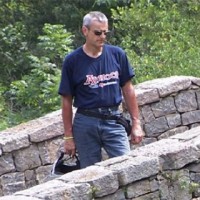 | beppeverge Very interesting interview of a nice person and a great photographer.
The book is on my Amazon wish list. |
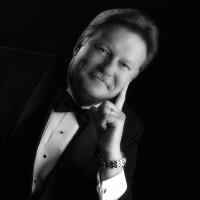 | Richard Reames PRO Wonderful tribute to an amazing photographer and human being. |
 | Ralf Stelander FOUNDER Absolutely outstanding photography! |
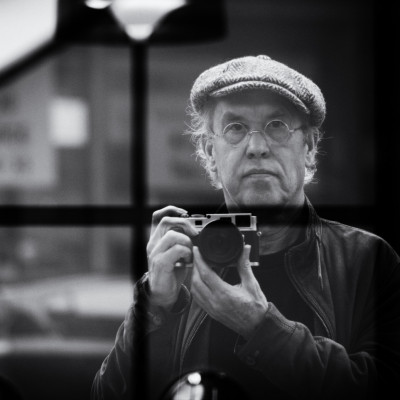 | Hans Martin Doelz CREW In addition: In my school class (in the early 60s) there was a 14 year old boy who became bald within a time frame of one year. First he had some areas on his head with missing hair in the size of a coin, these areas became more and more and in the end he was bald. Now he is marching towards an age of 70 and he is still bald. In those "good old" days which apparently were not as good as we seem to remember, stigmatization of those people was the not uncommon behavior of the "normal" people. |
 | Yvette Depaepe CREW A story related fact ... Thanks for mentionning it !!! Glad you like the interview, Hans Martin ...
Best greetings ! |
 | Hans Martin Doelz CREW Exceptional images, great interview ! Thanks to Marc, Jimmy and Yvette. By the way, I think Jimmy used a Linhof (not Lindhof) camera when he shot his warrior in the desert.
Would be a good proof reader in the team ;-)
Cheers, Hans-Martin |
 | Yvette Depaepe CREW Thanks for noticing this error, Hans Martin. I will change it right away. Don't blame our proof reader who is a "professional" one. Hans Spiegel is excellent. This may be a "type" error from me (very technical for many of us). Cheers, Yvette |
 | Hans Martin Doelz CREW Didn't want to blame anyone, Yvette. I wouldn't have noticed it (the type error) if Jim Rakete (who took several portrait photographs of me) would not have realised a project some years ago named 1/8 second. In this project he used a very old Linhof plate camera and portraited famous german film-actors. The actors had to sit absolutely still during the shooting, the shutter speed was 1/8 second. A very interesting project. Greetings to Hans Spiegel, I really don't want to replace him. In addition, English is not my native language. When I joined 1X about three years ago I had to look in the dictionary for about a quarter of the german words I had to translate when writing my comments. Fortunately this has changed. Cheers, Hans-Martin |
 | Yvette Depaepe CREW It's fine, Hans Martin ;-) Just know that I'm very grateful for making this very important rectification. ;-) |